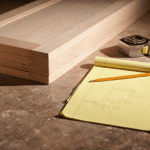
Woodworking is a deeply satisfying hobby that marries creativity with technical skill. Whether you’re building furniture, crafting decorative items, or fixing things around the house, the art of woodworking can offer immense satisfaction. However, many enthusiasts shy away from starting or expanding their woodworking projects due to concerns about the high cost of tools and materials. The good news is that woodworking doesn’t have to break the bank. In this blog post, we’ll explore various strategies to pursue your passion for woodworking while sticking to a budget, ensuring that you can create beautiful, functional pieces without overspending.
Starting with the Right Plan
Embarking on any woodworking project without a plan is like setting off on a road trip without a map; you might eventually get somewhere, but you’ll likely waste a lot of time and fuel along the way. Before you cut a single piece of wood, it’s crucial to have a detailed plan. This approach helps minimize waste by ensuring you only buy and cut the materials you need. There are plenty of resources where you can find free or low-cost woodworking plans. Websites like Ana White or Woodworkers Workshop offer a variety of plans for all skill levels, from beginner to advanced. By selecting a plan suited to your skill level and the tools you already have, you can avoid purchasing unnecessary equipment.
Sourcing Affordable Materials
One of the biggest costs in woodworking is the materials, but there are ways to keep expenses low. Start by visiting local lumber yards and hardware stores to ask about discounts on remnants or slightly damaged goods, which are often available at a reduced price. Another excellent option is to use reclaimed wood. Not only is it cheaper, often even free, but using reclaimed wood also adds character to your projects and is better for the environment. Places to look for reclaimed wood include construction site dumpsters (with permission), old barns, and salvage yards. Preparing and treating this wood yourself can be a rewarding part of the woodworking process, though it requires some time and effort.

Choosing the Right Tools
When you’re just starting out, it might seem like you need every tool in the catalog, but that’s not the case. Focus on acquiring essential tools that can be used for multiple tasks. Tools like a good quality saw, a reliable drill, and a versatile hammer will serve you well across many projects. Buying secondhand tools is a great way to save money. Check out online marketplaces, garage sales, and estate sales for deals on used tools that often just need a bit of cleaning or sharpening to be as good as new. For those who only need certain tools occasionally, consider renting instead of buying. This can significantly reduce your initial investment while still allowing you to work on and complete your projects.
Maximizing Workspace and Storage
Not everyone has the luxury of a spacious workshop, but a small space shouldn’t stop you from enjoying woodworking. Optimize the area you have by designing a smart layout where tools and materials are easily accessible. Utilize vertical space with wall-mounted shelves and pegboards to keep tools organized and off the workbench. DIY storage solutions such as under-bench bins and overhead racks can be made from leftover materials from your projects. Keeping your workspace organized is not only a necessity for efficiency but also crucial for safety.
Learning and Improving Skills
The journey of a woodworker is marked by continuous learning and skill enhancement. Fortunately, acquiring new skills doesn’t necessarily require expensive courses. The internet is a treasure trove of resources, offering a multitude of tutorials, video series, and blogs dedicated to woodworking. Sites like YouTube have channels specifically for DIY woodworking, where experienced woodworkers demonstrate techniques and projects step-by-step. Additionally, consider enrolling in community college classes or local workshops which are often offered at a modest fee and can provide hands-on experience under the guidance of skilled instructors. Another invaluable resource is online forums and local woodworking clubs where members share advice, tools, and even materials. Engaging with a community can accelerate your learning curve, help troubleshoot projects, and provide inspiration for new ideas.

Project Management and Efficiency
Effective project management is crucial to stay within budget in woodworking. Begin by estimating the total cost of materials and tools needed for your project. Keeping track of expenses as you purchase supplies can help you stay on target. Efficient use of materials and time can significantly cut costs. Plan your projects to minimize the number of tool changes and setups—batch cutting pieces that require the same saw setup can save time and reduce the wear and tear on your tools. Also, consider working on multiple small projects simultaneously to make the most of your materials and tools. This not only speeds up project completion times but also maximizes the use of your workspace.
Conclusion
Woodworking on a budget is not only possible, it can also add an extra layer of creativity to your projects. By planning carefully, sourcing materials wisely, and making the most of the tools and space you have, you can produce stunning pieces without a hefty price tag. Remember, every saved penny and repurposed material is a step towards sustainable crafting. Whether you’re a novice looking to dive into your first project or an experienced woodworker striving to reduce costs, the strategies outlined here can help enhance your practice without compromising quality.






